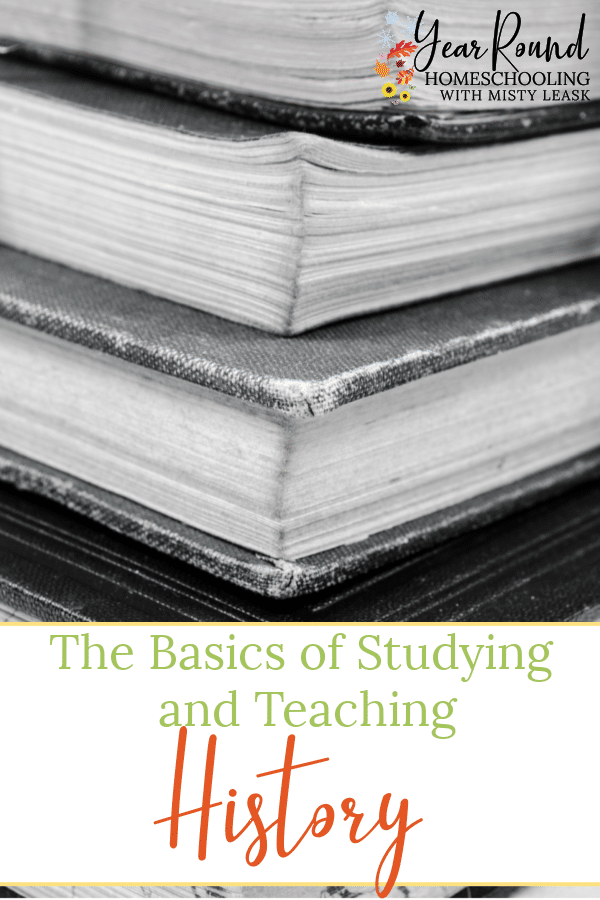History is one of those school subjects that either one loves or doesn’t care much about. That can make teaching history a challenge at times, but it can be done!

I have two boys; one of them absolutely loves history and is actually a history buff and the other one, not so much.
That being said, I am of the opinion that history must be taught. If one wants to have a well-rounded education, history must be one of the subjects that is mastered to some degree.
I am not saying you have to know all of the dates and places and give a full timeline of history perfectly. What I am advocating for is general knowledge of how we came to be what we are now.
Often we think of history as simply a list of dates and places or important figures and battles. It is so much more than that. History is really a story. As Christians, that story has even more importance once we understand that history reveals God’s own story in the world that He created in the first place.
I like this definition of history: “History is reading and thinking about people who have lived and acted before today so that we can learn from their successes and their failures.”
Another good definition is one taken from Teaching the Trivium: “History is a teller of stories. It is a narration of events in the order in which they occurred, and an attempt to explain their causes and their effects.”
Throughout history we learn from other people’s mistakes; as such it warns us. Through it we learn from other people’s successes; as such we are encouraged. History shows us the deficiencies of human nature and thus reveals the heart of human beings.
In other words, it is there to teach us. There is much to learn from what has happened before us and there lies the need to make history a vital component of a good education.
Another aspect of studying it from a Christian perspective is how it points to us to the sovereignty of God. Throughout history we see God’s character demonstrated and how He directs the affairs of all people. In studying history we see men’s actions at work, but we also see how God’s plan of salvation is being fulfilled.
There are plenty of different ways one can study and teach history, and over the next few months, we will go over a few of them. That said, whatever you use for teaching history, a few principles have to be kept in mind.
5 Tips for Teaching History
History can be fun.
It does not have to be a drudgery. Often we come at it with our own preconceptions, but it does not have to be. There are plenty of ways to make it fun and we will talk about that in a later post. The main thing is to come with enthusiasm and seek to make it alive through crafts, food, field trips, enactments, videos and games, just to name a few ways.
Enjoy and learn it alongside your kids.
Making history an interesting and engaging subject relies on the teacher’s own enthusiasm. I have come to appreciate it more as I have been studying it along with my boys. We need to learn to be open and creative as we seek to learn about people of old and the way God works things out to bring out His glory and purposes.
Dates and maps cannot be avoided. They do not have to be the heart of your study, and probably shouldn’t be, but they have to be included.
You cannot teach history without knowing when and where it happened. These elements are crucial for the correct understanding of history because they give context. Again, even though dates and maps are not the heart of what you need to teach, teaching them must not be neglected. A couple of great ways to teach dates and maps are through games and songs.
History has to be true to the facts.
One way of accomplishing this is to be very picky with what you use. Make sure you use biographies from different people in the time period in question, keeping in mind biases. History is never objective, so one must know how to decipher facts from point of view or perspectives.
A good study of history reflects on the facts and seek to analyze them.
This is where worldview and perspective come in. Usually, this stage is touched upon during the middle school and high school years, while the younger years are for mastery of the facts of history. Some elementary students can pick up on this, so it helps to be ready ahead of time just in case.
I hope that I have awakened your interest in history and that you and your children enjoy your history studies even more!
What is your favorite historical time period, Ancient, Middles Ages, Age of Exploration or Modern Times?
History doesn’t have to be boring! Be inspired and find fun ways to have your kids learn about history by following our Pinterest board below.
Follow Misty Leask’s board Homeschool: History on Pinterest.
